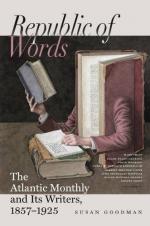[6] We refer to the new edition
of the novels of Cooper by Messrs.
W.A.
Townsend & Co., with illustrations by Darley.
This may be one reason why Cooper has more admirers, or at least fewer disparagers, abroad than at home. On the Continent of Europe his novels are everywhere read, with an eager, unquestioning delight. His popularity is at least equal to that of Scott; and we think a considerable amount of testimony could be collected to prove that it is even greater. But the fact we have above stated is not the only explanation of this. He was the first writer who made foreign nations acquainted with the characters and incidents of American frontier and woodland life; and his delineations of Indian manners and traits were greatly superior in freshness and power, if not in truth, to any which had preceded them. His novels opened a new and unwrought vein of interest, and were a revelation of humanity under aspects and influences hitherto unobserved by the ripe civilization of Europe. The taste which had become cloyed with endless imitations of the feudal and mediaeval pictures of Scott turned with fresh delight to such original figures—so full of sylvan power and wildwood grace—as Natty Bumppo and Uncas. European readers, too, received these sketches with an unqualified, because an ignorant admiration. We, who had better knowledge, were more critical, and could see that the drawing was sometimes faulty, and the colors more brilliant than those of life.
The acute observer can detect a parallel between the relation of Cooper to America and that of Scott to Scotland. Scott was as hearty a Scotchman as Cooper an American: but Scott was a Tory in politics and an Episcopalian in religion; and the majority of Scotchmen are Whigs in politics and Presbyterians in religion. In Scott, as in Cooper, the elements of passion and sympathy were so strong that he could not be neutral or silent on the great questions of his time and place. Thus, while the Scotch are proud of Scott, as they well may be,—while he has among his own people most intense and enthusiastic admirers,—the proportion of those who yield to his genius a cold and reluctant homage is probably greater in Scotland than in any other country in Christendom. “The rest of mankind recognize the essential truth of his delineations, and his loyalty to all the primal instincts and sympathies of humanity”; but the Scotch cannot forget that he opposed the Reform Bill, painted the Covenanters with an Episcopalian pencil, and made a graceful and heroic image of the detested Claverhouse.
The novels of Cooper, in the dates of their publication, cover a period of thirty years: beginning with “Precaution,” in 1820, and ending with “The Ways of the Hour,” in 1850. The production of thirty-two volumes in thirty years is honorable to his creative energy, as well as to the systematic industry of his habits. But even these do not constitute the whole of his literary




